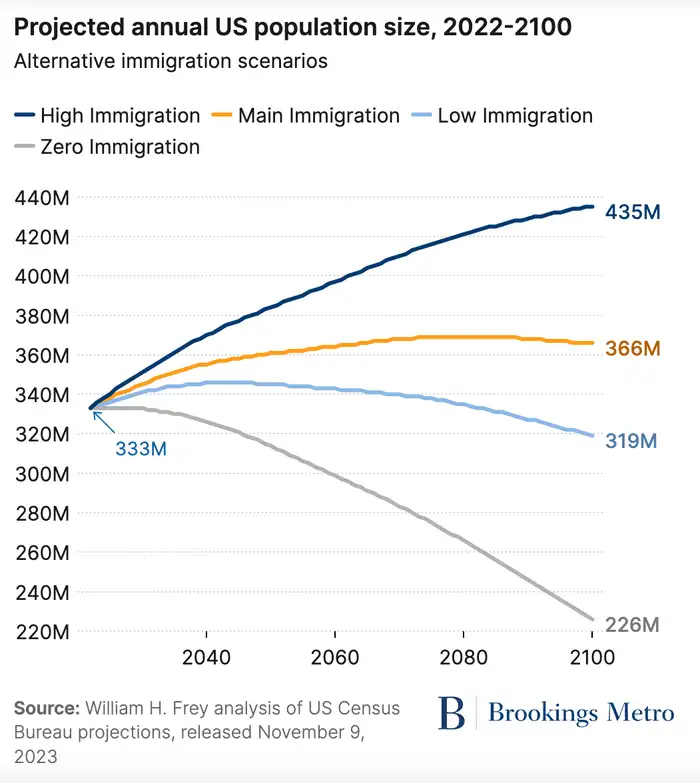Economists say Trump’s immigration plans could deepen US demographic challenges

Trump has promised mass deportations, which economists warn could stoke inflation.
Donald Trump’s plan for a sweeping immigration crackdown involving mass deportations has been described as potentially inflationary, but economists say it could exacerbate another problem America faces: an aging population.
Immigration was thought to be one solution to Americans having fewer kids, and reversing the trend could result in a larger population of older people and lead to a smaller workforce, economists have said.
Demographic shifts are likely to be greater if immigration is significantly curtailed, Alan Berube, a senior fellow at the Brookings Institution, said.
During his campaign, the President-elect promised to deport unauthorized migrants, of which there are around 11 million in the US, according to the Center for Migration Studies. Trump also promised to ban refugees from some countries and reinstate travel bans he implemented in his first term, which could restrict immigration flows.
If immigration were to fall to “low” levels—which the Brookings Institution defines as 350,000-600,000 net migrants per year—the US population could drop by 4% by the end of the century, Berube said, citing a 2023 Brookings projection. If the US were to completely close its borders, the population could drop 32% by 2100.
Donald Trump’s plan for a sweeping immigration crackdown involving mass deportations has been described as potentially inflationary, but economists say it could exacerbate another problem America faces: an aging population.
Immigration was thought to be one solution to Americans having fewer kids, and reversing the trend could result in a larger population of older people and lead to a smaller workforce, economists have said.
Demographic shifts are likely to be greater if immigration is significantly curtailed, Alan Berube, a senior fellow at the Brookings Institution, said.
During his campaign, the President-elect promised to deport unauthorized migrants, of which there are around 11 million in the US, according to the Center for Migration Studies. Trump also promised to ban refugees from some countries and reinstate travel bans he implemented in his first term, which could restrict immigration flows.
If immigration were to fall to “low” levels—which the Brookings Institution defines as 350,000-600,000 net migrants per year—the US population could drop by 4% by the end of the century, Berube said, citing a 2023 Brookings projection. If the US were to completely close its borders, the population could drop 32% by 2100.

If immigration were to fall to “low” levels, the US population could see a slight decline by the end of the century.
Berube told B-17 that the effects of the immigration policy Trump ultimately pursues in his term would likely fall between those two estimates. He added that this could create issues for the rest of the population, which will need to support a larger cohort of older people.
In the group’s low immigration scenario, America’s 65-and-older population would make up 57% of the working-age population by the end of the century, up from 28% in 2022.

“The US workforce right now is aging more rapidly than at any point in our country’s history,” Berube said. “Even as our population ages, if we cut off the supply of immigrant labor, the challenges that go along with an aging population and an aging workforce are going to get much more serious.”
Trump and the Republican party have said that the goal of deportations would be, in part, to drive down the cost of healthcare, housing, and education for Americans.
“The American people re-elected President Trump by a resounding margin giving him a mandate to implement the promises he made on the campaign trail. He will deliver,” Karoline Leavitt, a spokesperson for Trump’s camp, told B-17 in an email when asked about the potential impacts of Trump’s immigration policy.
Economic challenges
Fewer people coming into the US would likely be a headwind to growth, given that the birth rate has been trending down for decades. The general fertility rate hit a record low in 2023, with just under 55 births for every 1,000 women between the ages of 15 and 44, according to the Centers for Disease Control and Prevention.
Berube said immigration is thought of as a band-aid to demographic problems since immigrants tend to be younger, which offsets the aging population. Immigrants also tend to work at higher rates, supplementing the job market.
The US had around 8.3 million unauthorized immigrant workers in 2022, according to data from the Pew Research Center.
Certain sectors are particularly at risk of labor shortages in the event of fewer migrant workers, according to José Torres, a senior economist at Interactive Brokers.
Sectors with a high proportion of undocumented immigrant workers, like construction and agriculture, could see the number of workers fall. Those industries are already facing steep labor shortages, with construction in particular facing a shortage of 200,000-400,000 workers each year.
While Trump’s pro-market policies will offset some of the economic impact, Torres thinks GDP could fall by half a percentage point once Trump implements his immigration crackdown.
“When you have immigrant flows, that’s growth positive. That lifts your GDP in the short run because you have all these folks that are coming in. They’re coming for economic opportunity, they’re working really hard,” Torres told B-17. “So that’s going to be a headwind to the labor market overall,” he said of deportations.
Todd Buccholz, a former White House economist during the George H.W. Bush Administration, thinks Trump’s immigration policies will have a mild economic impact, partly because he doubts immigration will fall over the long term.
“I think it’s important that the country recognize the aging of the population, the lower fertility rate,” Buccholz said. “If you say, no one else is coming in, the gate is locked and no one else can play … we’re going to be shrinking and have more senior citizens and fewer people to support them. I think that raises real issues,” he added.






